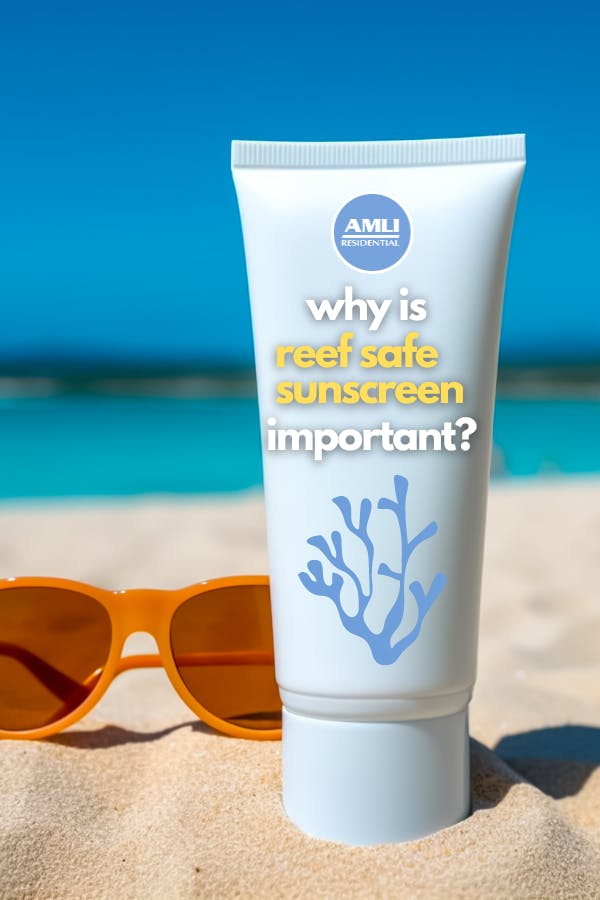You may have heard the term “reef-safe sunscreen” floated around your latest beachside excursion or snorkeling trip. So, what does it mean?
Reef-safe sunscreen attempts to mitigate the harmful effects of coral bleaching and chemical-based toxins to marine life all over the world, and in some places it’s illegal to sell anything other than reef-safe sunscreen!
Here’s all you need to know about reef-safe sunscreens and why they’re so important to not only our own health, but to the health of a quarter of all marine life!
All you need to know about reef-safe sunscreen
What is sunscreen and what does it do?
Sunscreen is designed to do one job: block the sun’s ultraviolet (UV) rays from damaging your skin. Ultraviolet A and Ultraviolet B radiation cause skin aging and skin burning, respectively, by damaging the DNA found in the cells of our skin. Without DNA, our cells don’t really know what to do and they start growing all out of whack — this can cause skin discoloration, sunburn, wrinkles, premature aging and, in extreme cases, skin cancer.
It doesn’t matter what the temperature is, because UV rays travel with light, not heat. That’s why people who summit high mountain peaks are extra-vigilant with wearing sunscreen, because the UV rays are so much stronger at high altitudes where the UV concentration is stronger and less diluted! If you’re at a beach at sea level, those UV rays will not be as strong, but they will still cause some major damage.
That’s where sunscreen comes in! Sunscreens can include anything that protects you from the sun — like hats, sun shirts, umbrellas or sunglasses — but in this case we’ll focus on the kind of sunscreen that you apply to your skin.
There are two major kinds of sunscreens on the market today: mineral-based sunscreens and chemical-based sunscreens. Mineral sunscreens use physical blockers, such as zinc oxide and titanium dioxide, that sit on top of the skin and deflect UV rays away from the body. Chemical sunscreens contain ingredients that absorb UV rays, converting them into heat that is then released from the skin. Some common chemical sunscreen ingredients include oxybenzone, octinoxate, octisalate and avobenzone — we’ll get to some of these in more detail later.
In addition to the active ingredients, sunscreens also contain inactive ingredients, such as water, oils and emulsifiers, which help to keep the sunscreen spreadable and stable.
The sun protector factor (SPF) is another important piece of information that’s listed on a bottle of sunscreen, no matter the type. This number refers to the percentage of UV rays the sunscreen keeps off your skin — however, it’s important to note that the SPF rating only refers to UVB rays (the ones that burn your skin) and not to UVA rays (the ones that age your skin). If you want to block those, too, then make sure to get a broad-spectrum sunscreen!
Here’s what the SPF rating means:
- SPF 15 blocks about 93% of UVB rays,
- SPF 30 blocks about 97%,
- SPF 50 blocks about 98% and
- SPF 100 blocks about 99%.
As you can see, there’s not too much of a difference between SPF 100 and SPF 30; even SPF 15 is just 6% below SPF 100! It’s a common misconception that a higher SPF means you can be out in the sunshine for longer, but most sunscreens will sweat off after about two hours (no matter the SPF) and you’ll need to reapply anyways. So don’t let the higher number give a false sense of confidence!
Why are some sunscreens harmful to marine life?
Coral reefs account for around 25% of all marine life that we know of. They provide shelter for small fish, hunting grounds for large fish and erosion control for beaches, just to name a few, and they’re a popular draw for tourists and water recreationists all over the world! However, human activity and climate change are contributing to the steady decline of healthy coral reefs, and sunscreens could be a big part of it.
Around 4,000 to 6,000 tons of sunscreen washes into our oceans each year, and all those chemicals — along with rising sea temperatures and coral bleaching — are factors related to the death of corals and, as a result, entire ecosystems.
Chemical sunscreens use oxybenzone (among other ingredients) to absorb UV rays rather than reflect them, turning the radiation into heat. Studies show that oxybenzone reacts to light and can become toxic when absorbed by marine creatures like coral and anemones. These phototoxins damage cells in the organism and, over time, can kill it entirely.
Now, coral is a symbiont organism that’s made up of a structure of small polyps covered with algae that converts sunlight into sugars, feeding the small creatures. In return, the polyps provide structure for the algae to grow on, and the colorful algae keeps converting all that sunlight into food. The algae also absorbs harmful chemicals like oxybenzone and protects the coral polyps from the toxin!
Rising sea temperatures and environmental stressors cause corals to expel their algal symbionts in an effect known as coral bleaching — without algae, the corals can’t eat, can’t protect themselves from UV rays and, in this case, can’t avoid the harmful effects of oxybenzone.
So, while oxybenzone doesn’t cause coral bleaching, it can still damage cells that aren’t protected by some kind of light-absorbing layer. Bleached corals, anemones and small, delicate animals of all kinds are at high risk of phototoxic damage, which is why it’s important to keep as much of it out of the oceans as possible!
What does reef-safe sunscreen mean?
“Reef-safe” sunscreen is sometimes paraded as a catch-all term for “good” sunscreen, but be a smart consumer! What you’re looking for is a broad-spectrum, mineral-based sunscreen that contains only zinc oxide and titanium dioxide, which reflect rather than absorb UV rays.
Ideally, though, the safest kind of sun protection you can find is UV-rated clothing like sun shirts, rash guards, hats and sunglasses. This prevents any kind of runoff (mineral, chemical or otherwise) and will keep you protected for longer than a two-hour sunscreen will. Stay out of the sun between 10 a.m. and 2 p.m. when the UV rays are strongest, and bring an umbrella, tent or other type of shady covering if you plan on being out for a while.
How to swim in the sunshine, sustainably
Ultimately, sunscreen is what we use to keep ourselves safe from the sun’s harmful UV rays. However, it’s just one tool we can use out of many, so it’s worthwhile coming prepared in a few different ways, too.
- Wear reef-safe sunscreen
- Bring a hat
- Utilize UPF sunwear
- Bring some shade
- Pack up after yourself
Reef-safe sunscreen and reef-safe sun protection measures are just a few of the factors we have to consider as we recreate in the ocean. Everything we do makes a difference, so let’s make sure that what we do leaves the planet in better shape than before!
Have fun!
Pin it!

Featured photo by Stanley Dai on Unsplash


 View All Posts by Colleen Ford
View All Posts by Colleen Ford